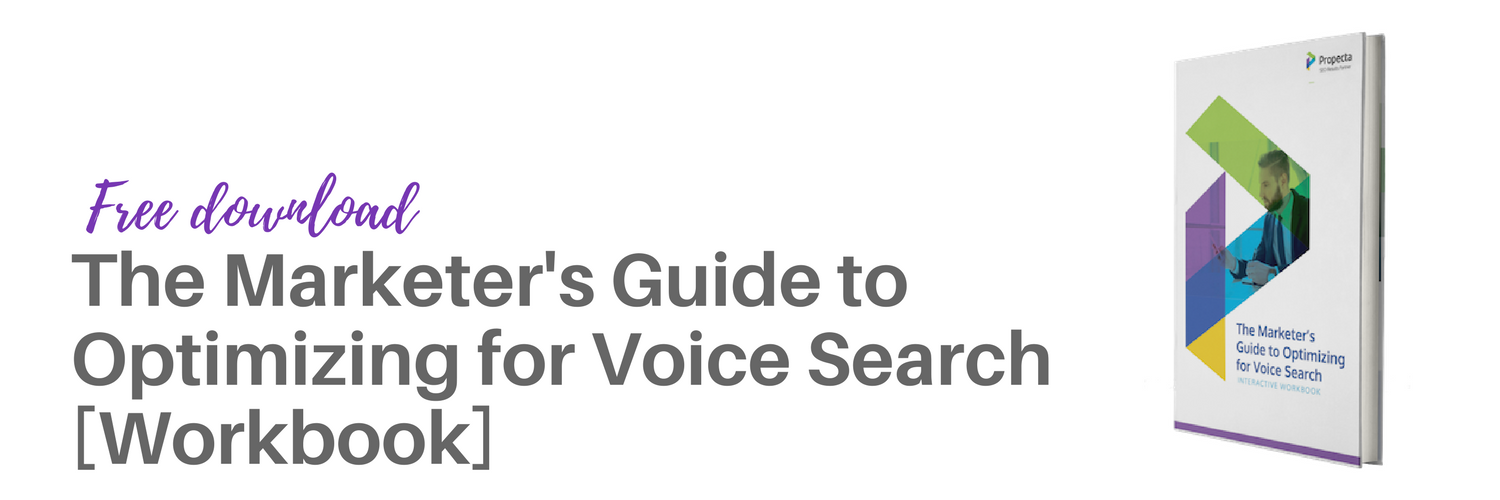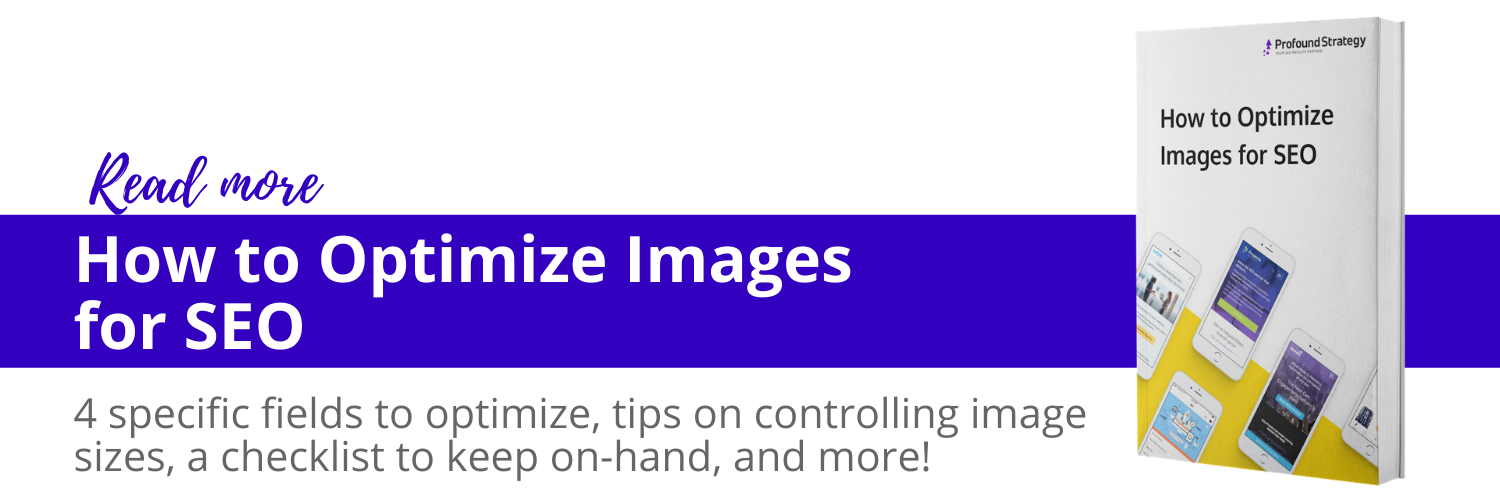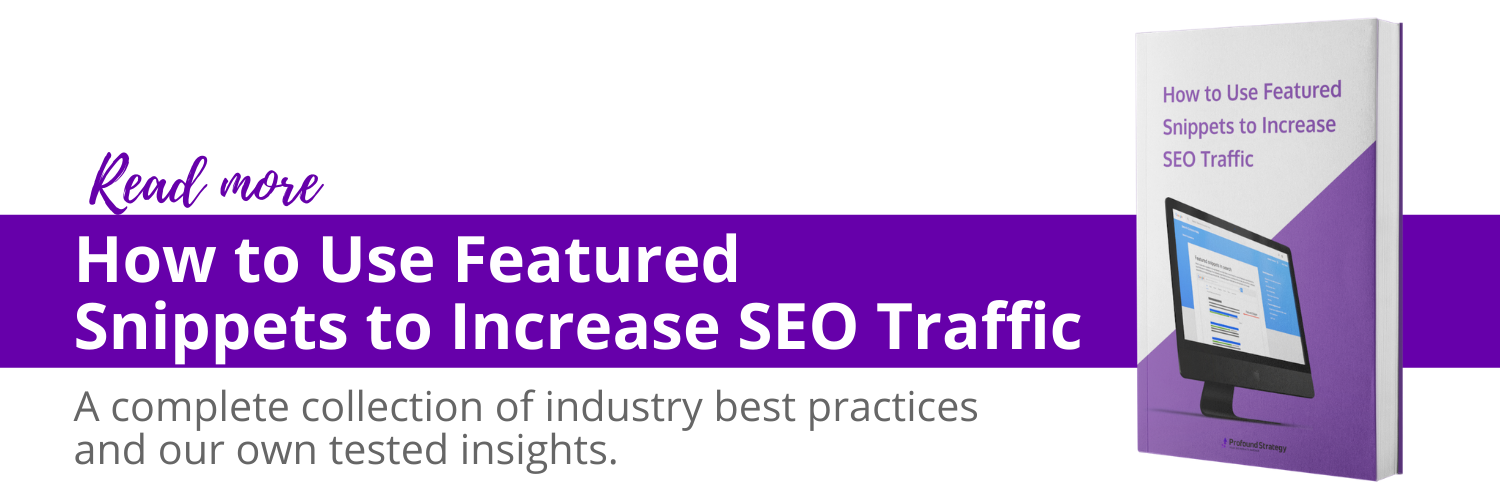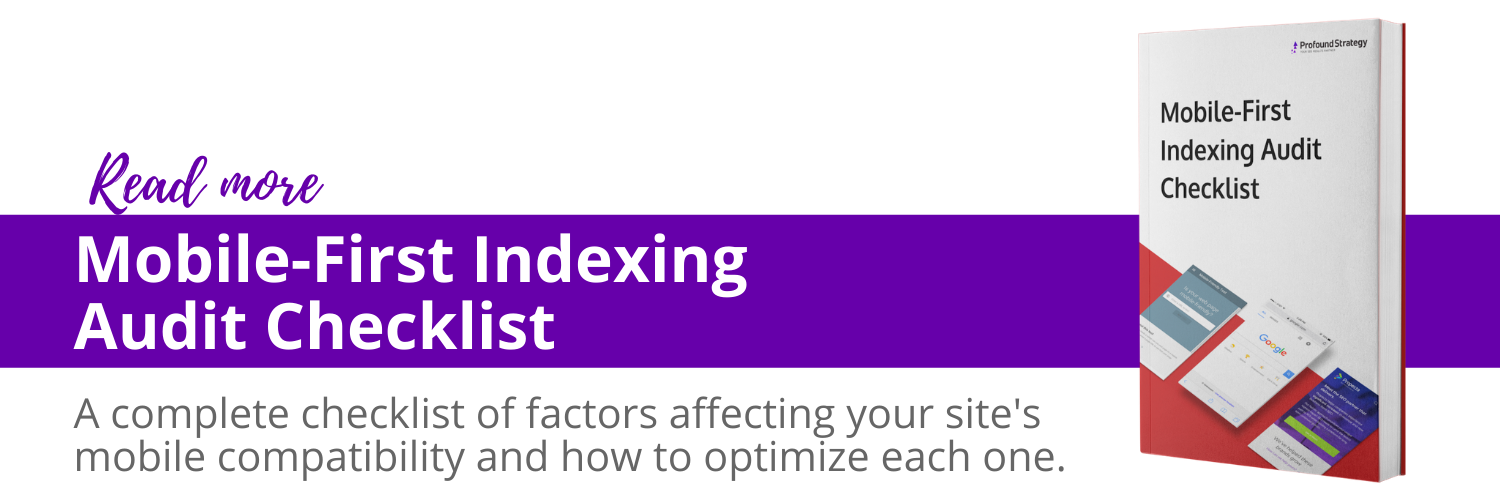The Ultimate SEO Strategy Guide for 2020
The internet has changed since Google first started guiding users to all corners of the web for sought-after information. Evolving search algorithms, new media formats, and endless additional developments mean people use the internet differently than they did in the early days of search engines.
As we ring in 2020, what does all the change mean for a marketer’s SEO strategy? Whether you’re just diving in, or updating an old strategy, what does SEO look like in 2020?
Here is the complete, practical guide to SEO in 2020:
- Some SEO Basics: SEO, Why It Matters, and How Google Ranks The Internet
- Keywords and Search Intent Aren’t Enough for SEO in 2020
- How to Create the Best SEO Content in 2020 and Beyond
- Google’s RankBrain and the Importance of User Experience
- Embrace Non-Traditional Searches: Voice and Image Searches
- Rank for Position Zero: Featured Snippets
- Use Video to Your Advantage
- SEO Backlinks in 2020 (and Beyond)
- Domain Authority vs. E-A-T
- Determine If You Need to Utilize Local SEO Tactics
- Technical SEO is Foundational
- Leverage the Right Tools to Help Track and Measure SEO Performance
Some Basics: SEO, Why It Matters, and How Google Ranks the Internet
Before diving into the nuts and bolts of how to successfully implement SEO in 2020, it’s helpful to start with some basics.
SEO, or search engine optimization, is a digital marketing discipline that aims to help a website earn a greater volume of relevant visits from the unpaid, “organic,” results provided by search engines. It consists of a few broad categories:
On-page optimization ensures search engines understand the overall topic and subject matter of a webpage, then ensures the page can match relevant search queries.
Off-page SEO is the collection of actions that businesses and publishers can take, or support, on other domains that also affect a site’s search ranking.
Technical SEO involves modifying behind-the-scenes aspects of web pages that aren’t actual content, and fine-tuning them for the web crawling and indexing performed by search engines.
Benefits of Modern SEO
Though some businesses are gun shy about pursuing SEO, there are many benefits to doing so.
First, effective SEO can improve the search rankings of online content and, subsequently, increase a business’s online visibility. Given the fact that Google fields roughly 1.2 trillion searches per year, and that people are more likely to click on the top organic results, SEO is key to attracting more potential buyers.
In fact, 67 percent of the average buyer’s journey is now digital. By leveraging SEO to achieve higher rankings on SERPs, businesses can capture more of this journey—driving more visitors to their websites and increasing the chances of more conversions and sales.

SEO also tends to be less expensive and more effective than many other marketing channels, resulting in higher return on investment (ROI). Indeed, 73 percent of in-house marketers and 76 percent of U.S. agencies say SEO provides excellent or good ROI.
Not to mention, the competition is surely using SEO, so if you want to out-rank them, you should, too. Not investing in SEO is leaving your target audience alone with the competition.
How Search Engines Work in 2020
It’s hard to truly master SEO without first understanding the basics of how search engines like Google rank online content.
Google in particular relies on powerful algorithms that evaluate web pages based on a long list of strategic considerations (“ranking factors”). It’s helpful to think of these factors as knobs in a control room.
Years ago, a team of engineers sat at the controls, “turning up” different ranking factors based on what they had learned about user preferences. This led to countless SEO checklists that attempted to discern which factors were turned up higher than others, so marketers could prioritize those in their SEO efforts.
Today, however, the control panel has a machine learning program named RankBrain, and it runs itself. Google’s algorithm adjusts the settings for each and every search—turning some of them up higher than others—based on what the machine has learned about user preferences for different devices, industries, keywords, and more.

Google is looking for the most relevant, helpful content for each query, and it uses this ever-shifting grid of ranking factors to determine which content is best.
Keywords and Search Intent Aren’t Enough for SEO in 2020
One of the ways SEO marketers can ensure their content is the most helpful to users—and thus earns higher SERP rankings and more organic traffic—is to understand the role of keywords in modern SEO strategy and how they intersect with search intent.
SEO Keywords
Search engines have always understood query terms as the starting point to figuring out exactly what users are asking for.
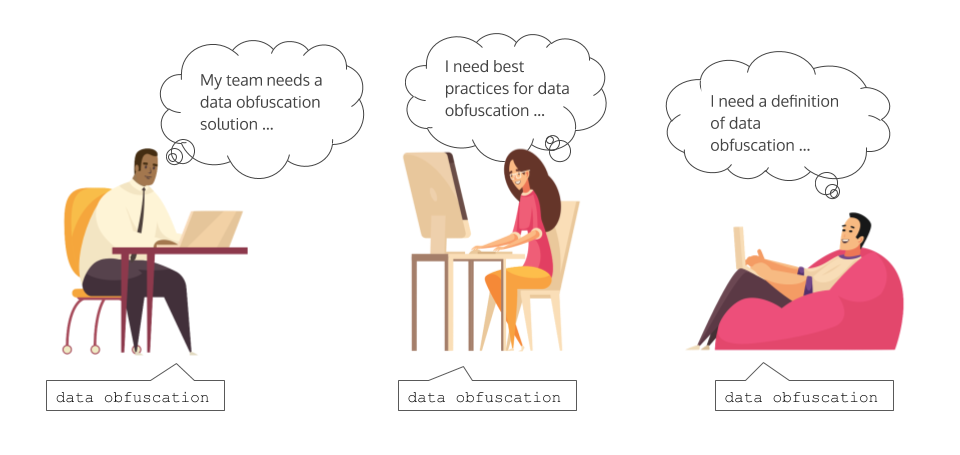
In the past, queries tended to be short and general, because search engines weren’t sophisticated enough to parse more natural, detailed language.
Now, though, Google can serve up results that are still relevant to the user, even if the results aren’t optimized for the specific search terms a person uses. This capability signals the declining importance of exact-match keywords. As a result, modern SEO approaches must instead prioritize search intent and users’ needs—or what motivates users to search in the first place.
Search Intent
Google breaks up search intent into four main categories, or “micro-moments”:
Know — The user wants to learn about a topic.
Go — The user wants to navigate to a physical location.
Do — The user wants to learn how to do something.
Buy — The user wants to make a purchase.
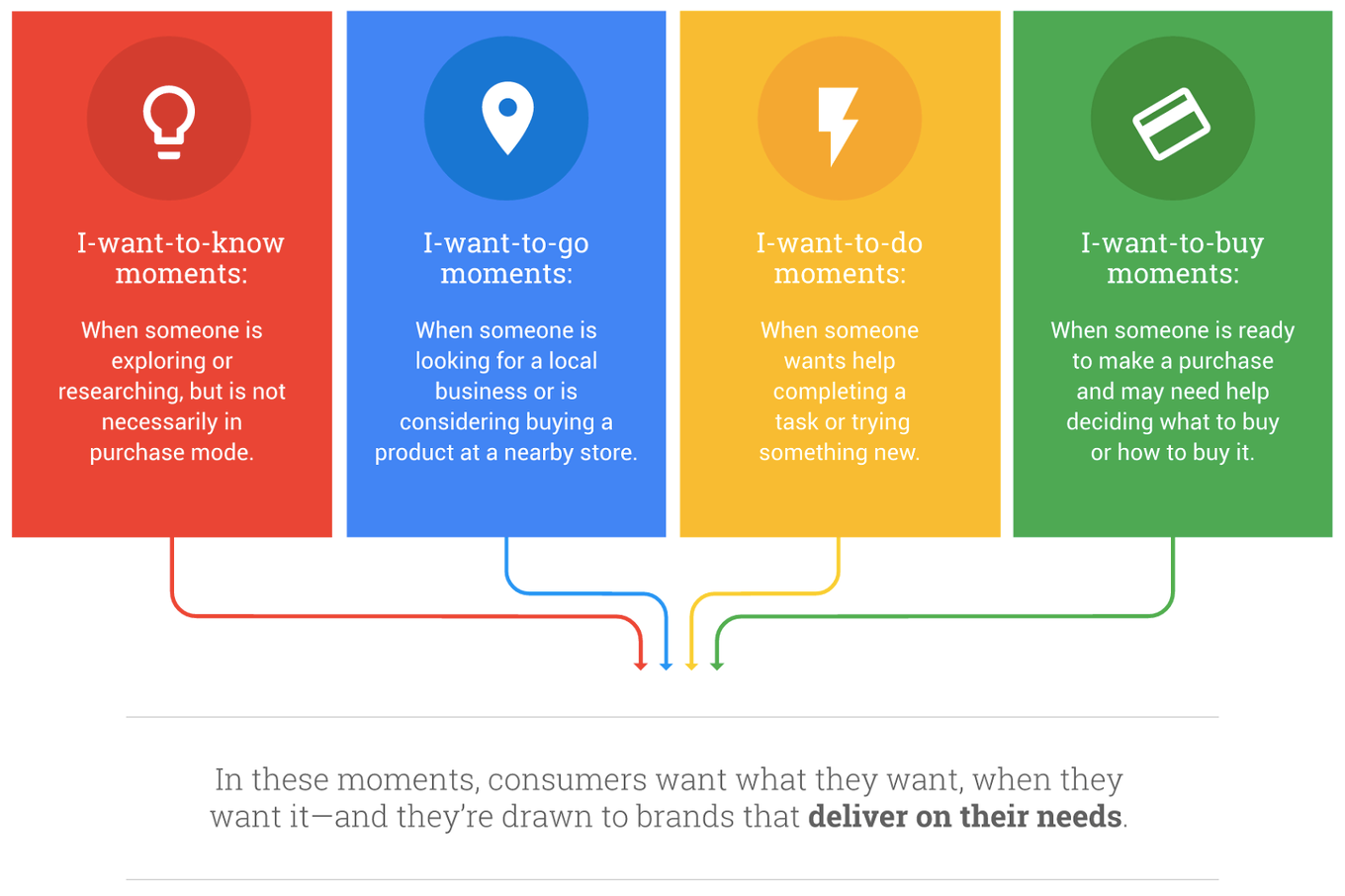
Search intent is a step in the right direction. It emphasizes the importance of understanding the real question or need behind a keyword or query. It forces marketers to put the user first and create content that is helpful to the target audience.
But it still isn’t enough to give marketers the insights they need to create truly competitive SEO content.
User Needs
Knowing a user’s search intent is helpful, but the most powerful insights come from narrowing that search intent down to a specific user need. While a user intent reveals generally what a user wants, a user need reveals the specific problem someone is looking to solve.
user need
a specific need that a user has, at a specific point in the buyer’s journey, that inspires an organic search query
Take, for example, this SERP for the term “data lakes.”
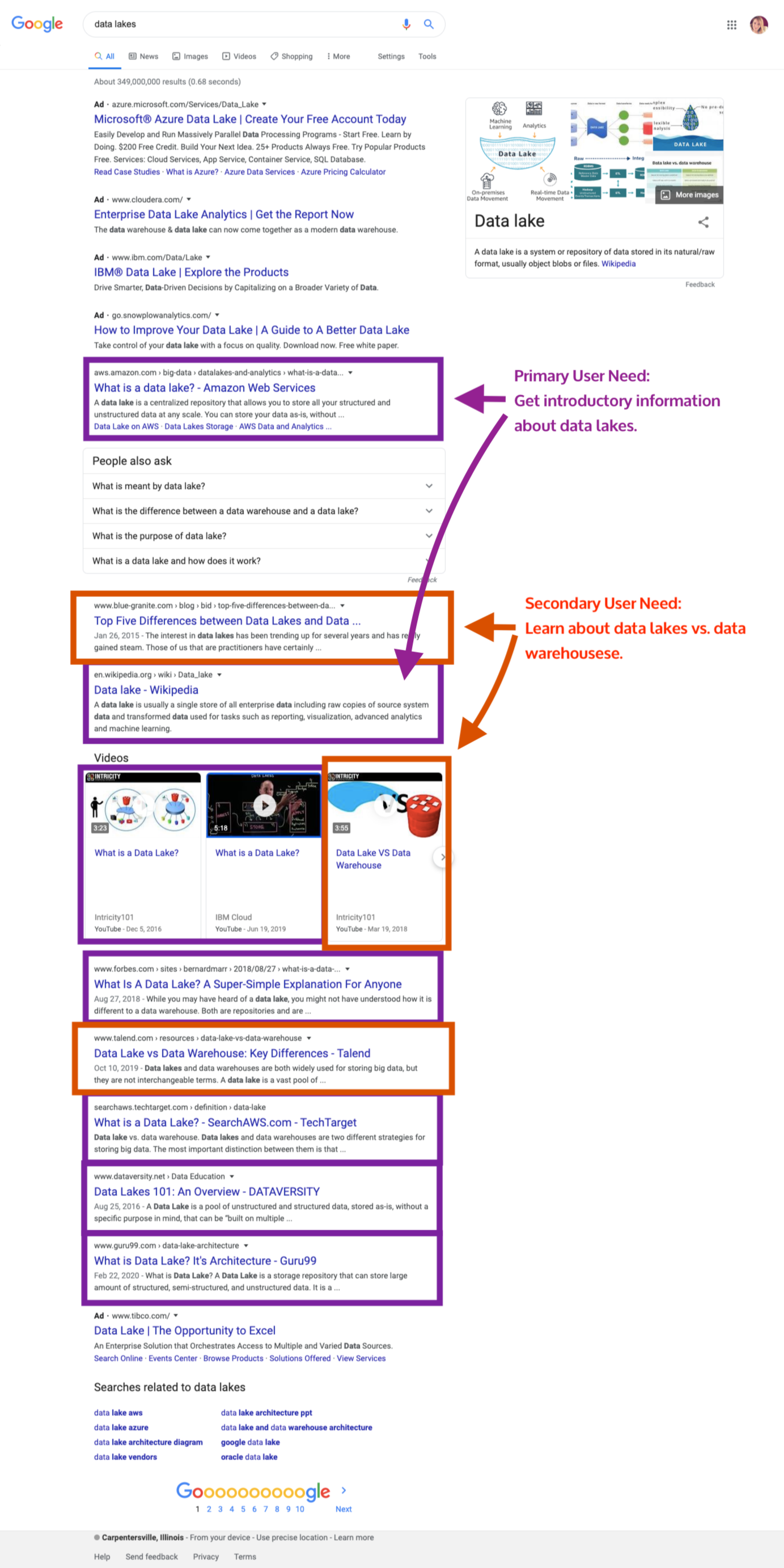
By studying the title tags and meta descriptions of organic content, we see that two distinct user needs are being addressed:
- I need a definition / overview of “data lake.”
- I need to learn the difference between a data lake and a data warehouse.
This is the sort of specificity that separates search intent (know) from a user need (learn about data lakes / learn about data lakes vs. data warehouses).
Both of the user needs for “data lake” would be classified as “know” intents, but that information isn’t enough to create outstanding content. Know … what? There’s a lot to know about data lakes.
Keep in mind that there isn’t a 1:1 ratio between user needs and keywords. One keyword can have multiple user needs—as above—and one user need is associated with more than one keyword.
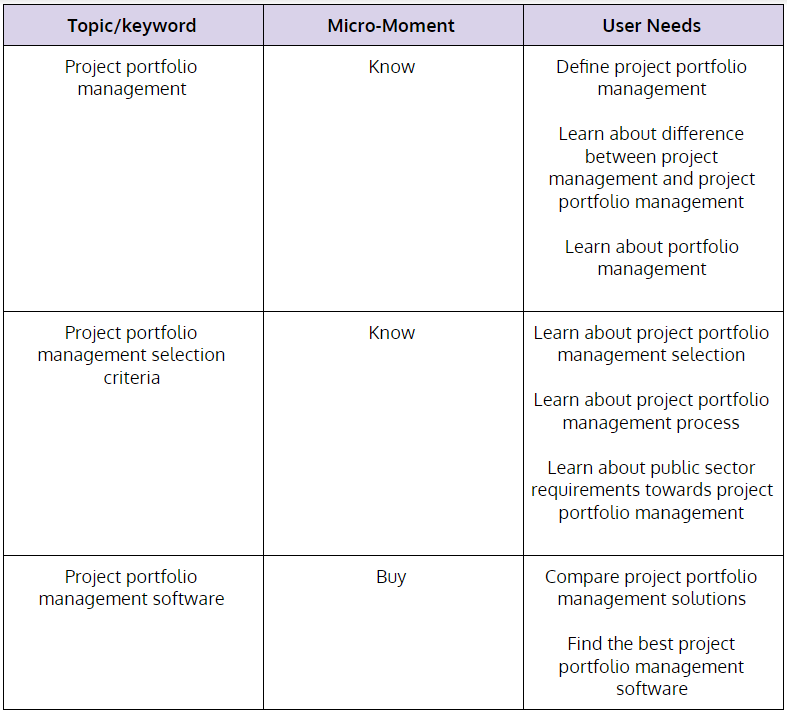
To unlock user needs:
- Compile a list of keywords that are relevant to the business’s marketplace and its buyers.
- Group related keywords into clusters or families that all have similar meanings, then edit or remove any irrelevant terms.
- Conduct a depersonalized search for the top keywords in a family, and survey the SERP to determine what user need(s) most aligns with the keyword.
- Repeat this process for other, similar keywords. Eventually, you should develop a list of specific user needs tied to keywords.
- Have stakeholders prioritize the list of user needs based on the needs’ relevance to the business.
How to Create the Best SEO Content in 2020 and Beyond
Once you’ve identified and prioritized user needs, it’s time to start creating killer SEO content.
Because for almost any user need, there are already hundreds—if not thousands—of existing pages and articles competing for the same clicks. Only those on the first SERP (and really, only those at the top of the first SERP) get substantial traffic.

CTRs by organic ranking on desktop and mobile as of January 2020
Your content has to be the best. This means standing out with more than just standard SEO practices like effective technical SEO, optimized headlines, or meta descriptions.
To move beyond those traditional tactics, marketers need to build content around nuanced insights into each specific user need.
SEO Research and Content Strategy
A critical step to creating the best content is understanding what search engines are already ranking highly—and why. To do this, some competitive research is in order.
Start by gathering a list of the top-performing content for a user need. Remember that multiple keywords can represent a single user need, so be sure to examine SERPs for various related search terms. Stick to gathering the best three to five pages.
Next, compare and contrast those pages.
– How long is each piece?
– What sections and subtopics do they have in common?
– Are there any sections or subtopics they’re neglecting?
– Do these pages all incorporate custom images or multimedia?
Sussing out similarities provides valuable insight into what users find helpful, and, as a result, what qualities search engines are rewarding for that user need. They provide the crucial, research-backed foundation for the content creation process.
Expand to Create Exceptional Content
Once you’ve identified that foundation, it’s time to build something better. Start creating an outline with the shared elements of top-performing pages, then, expand on that foundation with:
Important subtopics that other top-content is missing — Prioritize the subtopics that are already there, because Google already knows those are important, but then add the missing information.
Content elements that add to the conversation — Maybe your company has a great video, or you can create a custom diagram to better explain an idea.
Unique thought leadership — Does your brand have a unique perspective or opinion on the topic? These insights can help your content stand out.
Users can benefit from this information, and it will put your content head and shoulders above what’s currently ranking.

The golden rule of this process, though, is to respect the research and the user need. If users want information, don’t get too sales-y. If one piece of the conversation keeps coming up, don’t ignore it. Instead, stick to providing what readers are actually looking for.
In short, to create the best content:
- Examine three to five top URLs for a user need. Compare and contrast these pages. Ask how they interrelate, how they stand out, and what’s missing.
- Create a foundational outline using all of the shared attributes of these pages.
- Expand on the initial outline with elements like unique thought leadership, more in-depth coverage, new examples or analogies, and other aides like visuals or videos.
Google’s RankBrain and the Importance of User Experience
Quality content is the core precept of modern SEO, but it’s important to know how search algorithms, particularly Google, actually assess that quality.
In 2015, Google announced an update to its search algorithm called RankBrain. The update uses machine learning to improve the algorithm by analyzing how users interact with content that Google ranks for each individual query.
For instance, RankBrain might adjust the main search algorithm for a set of queries to prioritize results with a high keyword density. If users click on and spend significant time on those pages, RankBrain will keep this keyword-density-favoring version of the search algorithm for related query terms, audience segments, devices, etc.
Google’s shift to focus on user experience metrics via RankBrain is something SEOs need to account for in their content creation strategies. A big part of this is user need identification and content built on SEO research, but it can be further supported with strategic CTR and UX considerations.
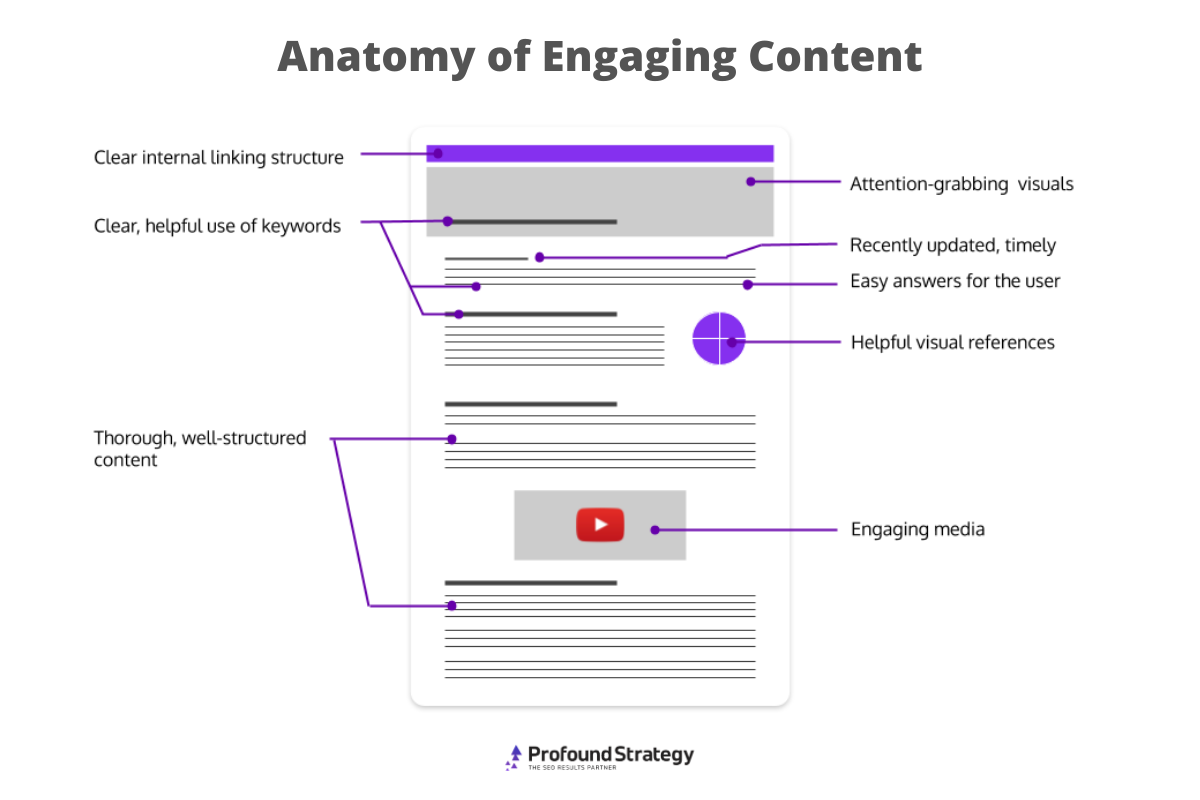
Tips for improving CTR and user engagement in order to win over RankBrain:
- Craft helpful, enticing page titles and meta descriptions that will get readers clicking through to your page. While the title confirms that a URL is relevant, and the meta description provides a sense of the details on a page, both should be compelling enough to entice people to want to read the associated content.
- Write concise intros that get to the heart of the problem or subject, giving people what they want as soon as possible.
- Incorporate visually engaging elements. Enrich readers’ experience with supplemental elements like video, images, embedded tweets, etc. Users gravitate toward longer content, but that doesn’t mean it should be a wall of text. Breaking content up with visuals helps improve readability.
- Keep readability in mind. Remember that reading online and on a mobile device is different from reading tangible materials. Use shorter paragraphs, varied sentence structure, and bulleted or numbered lists to help users quickly glean the information they need.
Embrace Non-Traditional Searches: Voice and Image Searches
Many tend to think of web searches as the traditional text queries inputted via keyboard, but voice and image search are quickly rising in prominence.
Voice Search
Voice search has exploded in the last few years, thanks to the popularity of smart devices like Amazon Echo and voice assistants like Siri. In fact, experts estimate that voice search will be a $40 billion channel in the U.S. by 2022.
Google recognized this meteoric rise in voice search in 2019 with its BERT search algorithm update, hailed as their most significant in five years. The update helps the search algorithm parse conversational searches that are often dependent on word order, a phenomenon prevalent in voice searches.
This trend toward understanding longer, more detailed searches is yet another signal that Google cares less about traditional concerns of SEOs like keywords and instead is favoring results that meet user’s specific needs.
However, voice search isn’t of equal concern to everyone. Most people use voice search for quick, definitional answers or to buy household items, so it hasn’t been much of a concern for B2B industries.
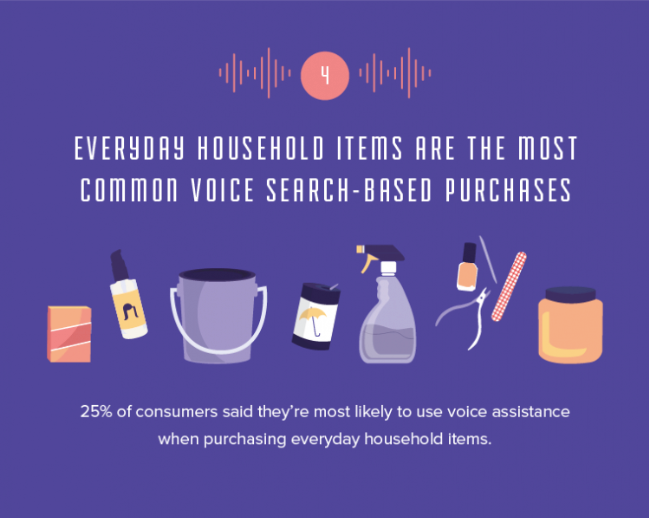
Still, voice search does give brands the opportunity to interact with users, so it can be worth pursuing. There are several steps marketing professionals can take to to account for the trend toward voice search:
Target featured snippets. Google often uses the contents of featured snippets as answers to voice queries, because they are self-contained, simple, and pre-validated. Pages that earn featured snippets need to first rank on page one of Google’s organic results, and also provide a clear, concise answer to the user need—usually near the top of the page.
Create content for long-tail keywords. Because voice search involves more natural language, it’s helpful to optimize for more specific, long-tail keywords that are made up of at least four words.
Image Search
The other rising search trend is image search. In fact, Google’s image search tool, Google Lens, has already been used over a billion times since it hit the public in 2017.
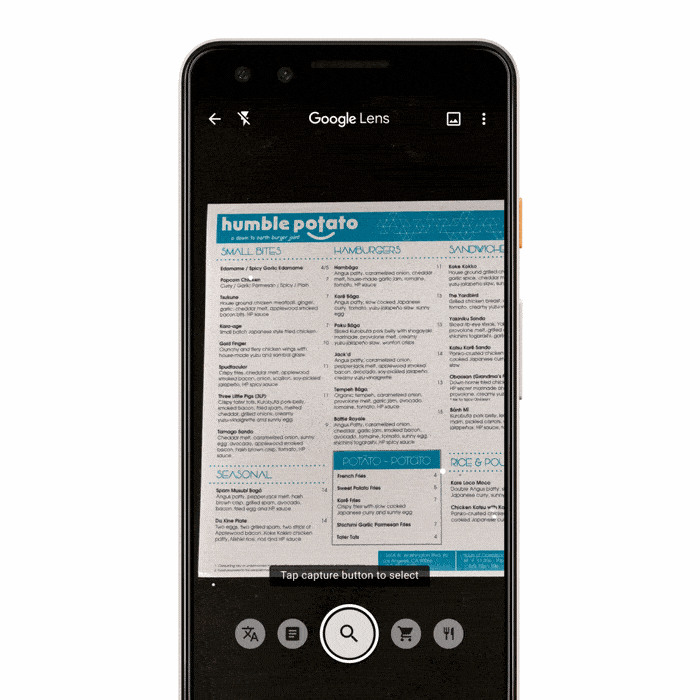
Visual searches like those powered by Lens help people identify real life objects surrounding them quickly and efficiently. Plus, visual search is a natural extension of behaviors users typically associate with their phones, i.e., taking pictures and using a phone camera.
To keep up with the increasing popularity of image searches, SEOs should be sure to:
- Write helpful alt text. Search engines rely on alt text when they can’t display an image and to make search more accessible to those with visual impairments. So ensure that search engines can easily index the alt text and that it accurately describes the image.
- Write engaging image descriptions. It’s not enough to accurately describe an image. Google and its peers prioritize descriptions they deem expressive, distinct, and relevant.
- Update with timely images. Google’s image search algorithm prioritizes pages that have been recently updated, so keep images and content fresh with regular changes.
- Make images relevant and prominent. Google’s image search algorithm also favors pages where the image is higher up and more prominent on the page. Ensure photos and other relevant images aren’t buried far down on the page.
Rank for Position Zero: Featured Snippets
A featured snippet is an organic snippet at the top of the SERP that includes longer content scraped from a chosen website. Google in particular only pulls featured snippet information from links that are already ranking on page one.
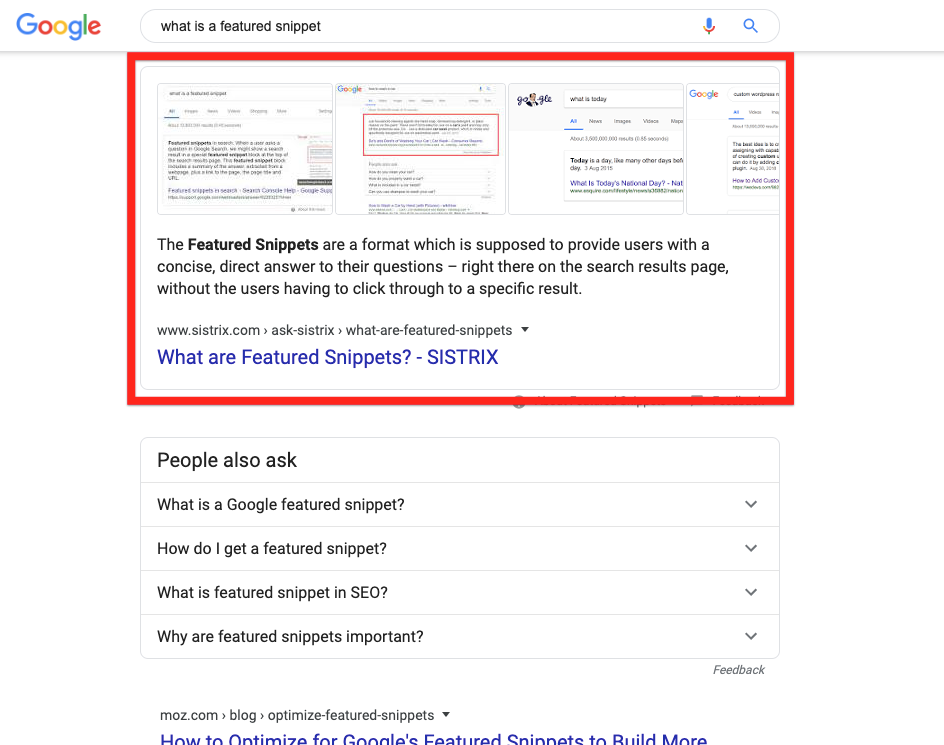
A featured snippet about featured snippets
Note that featured snippets are not answer boxes. An answer box appears when Google provides an answer on its own. Answer boxes do not include a page title and link to other content, because the information comes from Google’s own resources.
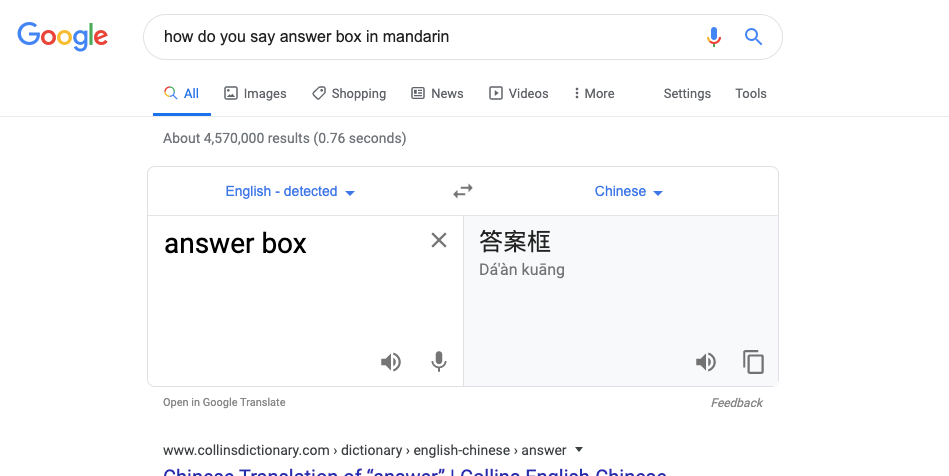
Featured snippets aim to provide a concise answer the main user need associated with a keyword. Google a head term or a “what is” query, and the SERP will likely include a featured snippet that scrapes a definition of the term from top organic content.
For years, earning a featured snippet was a coveted achievement, because it not only created a measure of prestige, but the link that won the spot appeared twice on page one: in the featured snippet and also in its normal organic ranking.
Recently, though, Google did away with this duplication. Now, the URLs in a featured snippet appear only there, and the change has many SEOs debating whether or not winning position zero is a boon. (And it’s still too early to determine the true impact, if any, this deduplication will have on traffic and rankings.)
If a web page listing is elevated into the featured snippet position, we no longer repeat the listing in the search results. This declutters the results & helps users locate relevant information more easily. Featured snippets count as one of the ten web page listings we show.
— Danny Sullivan (@dannysullivan) January 22, 2020
For those who don’t want to deal with the uncertainty, there is a way to opt-out of being included in a featured snippet. However, there may be cases where it still makes sense to target featured snippets.
Whether or not to target featured snippets in 2020 and beyond comes down to each individual brand and its SEO goals.
Learn more about featured snippet deduplication and what it means for your SEO strategy. →
For brands that do want to target featured snippets, at least for some pages:
- Identify pages that already rank on SERP 1, for queries that are also producing a featured snippet.
- Investigate the content in the featured snippet, and the page it comes from. What question is being answered? Why might Google prefer that page over others?
- Tweak content on your page to provide a better UX overall, and make sure there is a clear, concise answer that Google can scrape into a featured snippet.
Use Video to Your Advantage
Image and voice searches might still be relatively new to users, but people have been hungry for video results for years.
Experts predict that video will account for roughly 82 percent of global online traffic by 2022.
43 percent of users want to see more video from marketers in the future.
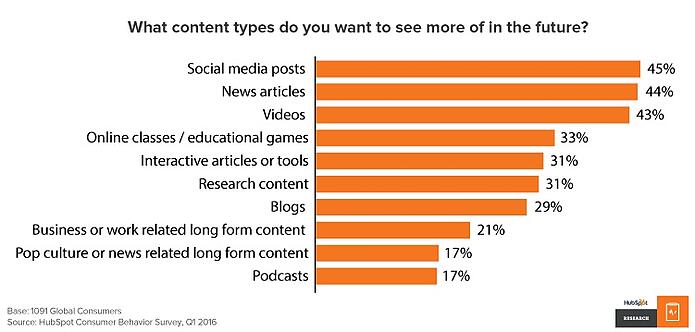
Smart SEOs realize the importance of video’s popularity: people love them, they get lots of links, and they can even be pulled in to featured snippets. Google’s “suggested clip” box works as a kind of non-text featured snippet that includes, and usually highlights the most relevant part of, a video.
In light of Google’s featured snippet de-duplication, videos still provide an opportunity to show up twice on one SERP.
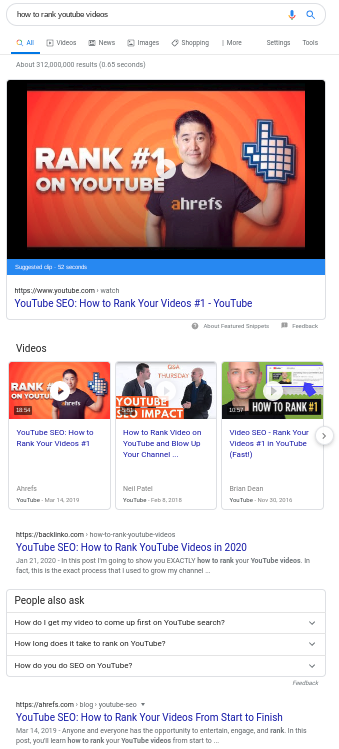
Though video can be a great way to increase visibility, there are several critical action items to ensure it has the greatest impact for a brand.
First is determining where to host the videos: directly on a brand’s site or on a third-party platform. YouTube is the most popular of these platforms, and the way to get videos on SERPs. But keep in mind that if users click on a YouTube-hosted video, YouTube will earn that traffic, not the business that created it.
Additionally, YouTube’s search algorithm is completely different from that of standard search engines. Optimizing videos to perform well on YouTube (and, thus, be chosen for Google’s page one features) is an additional project.
Second, understand the importance of any text that accompanies a video. Search engines can’t watch a video to understand its contents like people can—they rely on associated text like transcripts, meta descriptions, alt text, etc. Because of this, SEOs should ensure that any and all text that’s paired with a video is complete and descriptive.
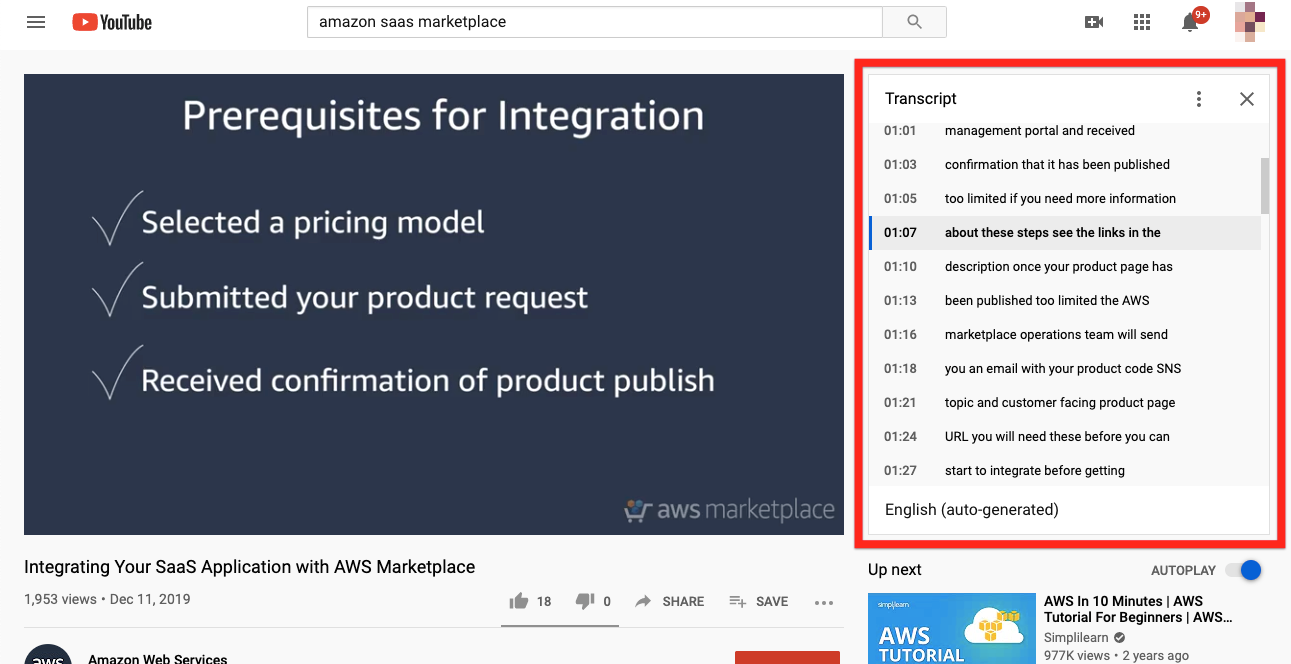
Third, don’t forget about structured data. Similar to accompanying text, structured data gives crawlers a clear heads up that it’s about to index a video. This information helps the crawlers more quickly and accurately index the video and any information tied to it. It also increases the odds that Google will pull the video into a Suggested Clip box.
In order to leverage video as part of an SEO strategy, marketers should:
- Decide on a hosting platform. Should the video live on a content site like YouTube, or live locally on your website?
- Provide a video transcript, if appropriate.
- Mark up with structured data. Use tools like Google’s Structured Data Testing Tool to check what sort of schema markup, if any, a page has.
- Optimize all text associated with the video. The more detailed that text, the better.
- Create a video sitemap. Hire a developer to handle creating the sitemap, or take advantage of a Yoast plug-in.
SEO Backlinks in 2020 ( … and Beyond)
Along with keywords, SEO practitioners have long prioritized backlinks—links that lead from another domain to a page on your site. Search engines used to directly correlate backlinks with page relevance and domain authority, or how much trust a page or website has cultivated from users and its competition. The more links pointing back to a page or site, the stronger the authority.
It used to be easy to manipulate a site’s domain authority by buying backlinks via a black-hat technique called link farming. However, Google quickly started penalizing such practices. Now, it rewards sites that earn authentic, organic backlinks—typically by spending the time to create amazing content and promoting it via networking—from credible sites.
While many still consider backlinks a top ranking factor, their importance is decreasing in favor of user-friendly content. Plenty of top-performing URLs, especially content like news articles or pages about medical conditions, don’t have a significant amount of backlinks pointing to them.
Though backlinks are not vital to earning more traffic—and they’re often more time and effort than they’re worth—SEOs looking to earn them should:
- Remember that quality is key. Authentic backlinks are a publisher’s endorsement of other content, so you need to write the highest quality content.
- Rely on networking. Build relationships and connect with industry leaders, so you can share your awesome content with them once it’s published. Hoping for a link, or outright asking for a link, depends on that relationship.
It’s also important to be aware that sharing on social media is not link building. Links that users share on social media platforms only count as social shares. However, smart SEOs can take advantage of social media for networking and brand awareness.
Domain Authority vs. E-A-T
Domain authority is a score that a website earns based on the trust it has garnered with peers and users. It is now, however, a ranking factor or a number that webmasters can artificially create. Domain authority is descriptive, not prescriptive.
In that vein, Google encourages content creators to craft pieces that follow a framework called E-A-T: expertise, authoritativeness, and trustworthiness.
E-A-T isn’t a ranking factor on its own, but Google does look for user engagement metrics that signal expertise, authoritativeness, and trustworthiness.
It’s almost like we look for signals that align with expertise, authoritativeness and trustworthiness. We should give that an acronym like E-A-T and maybe suggest people aim for this. Oh wait, we did: https://t.co/1fs2oIS54L pic.twitter.com/xNL424dDdq
— Danny Sullivan (@dannysullivan) October 11, 2019
The parameters are more subjective and tricker to account for than some other SEO considerations. But in its Search Quality Evaluator Guidelines, Google goes into great detail about how to determine if a site or page has the qualities necessary to garner a good E-A-T rating.
Some of the main concerns SEO professionals should address include:
- Originality: Is there a unique perspective that differs from existing content? Make sure thought leadership is clear throughout the piece.
- Accurate and clear sources: Fact check not just stats but factual statements as well. Then, link to sources to back up claims and show users that you’ve done your homework.
- Comprehensiveness: Ensure content provides enough detail to be helpful to readers and appropriately address the user need.
- Transparency: Build trust with readers with brand/content transparency. Use a secure domain, implement and clearly post a privacy policy, and list easy-to-find contact information. Also, be honest about who’s writing content; include bylines and author bios with relevant credentials wherever possible.
Determine If You Need to Utilize Local SEO Tactics
Considering search engines index a global internet, it may seem counterintuitive or inefficient to invest in localized SEO efforts. Yet, for brick-and-mortar businesses, local searches—particularly mobile local searches—can be a boon:
50 percent of users who completed a local search on their smartphones visited a store the same day.
18 percent of local, smartphone searches resulted in a same-day purchase.
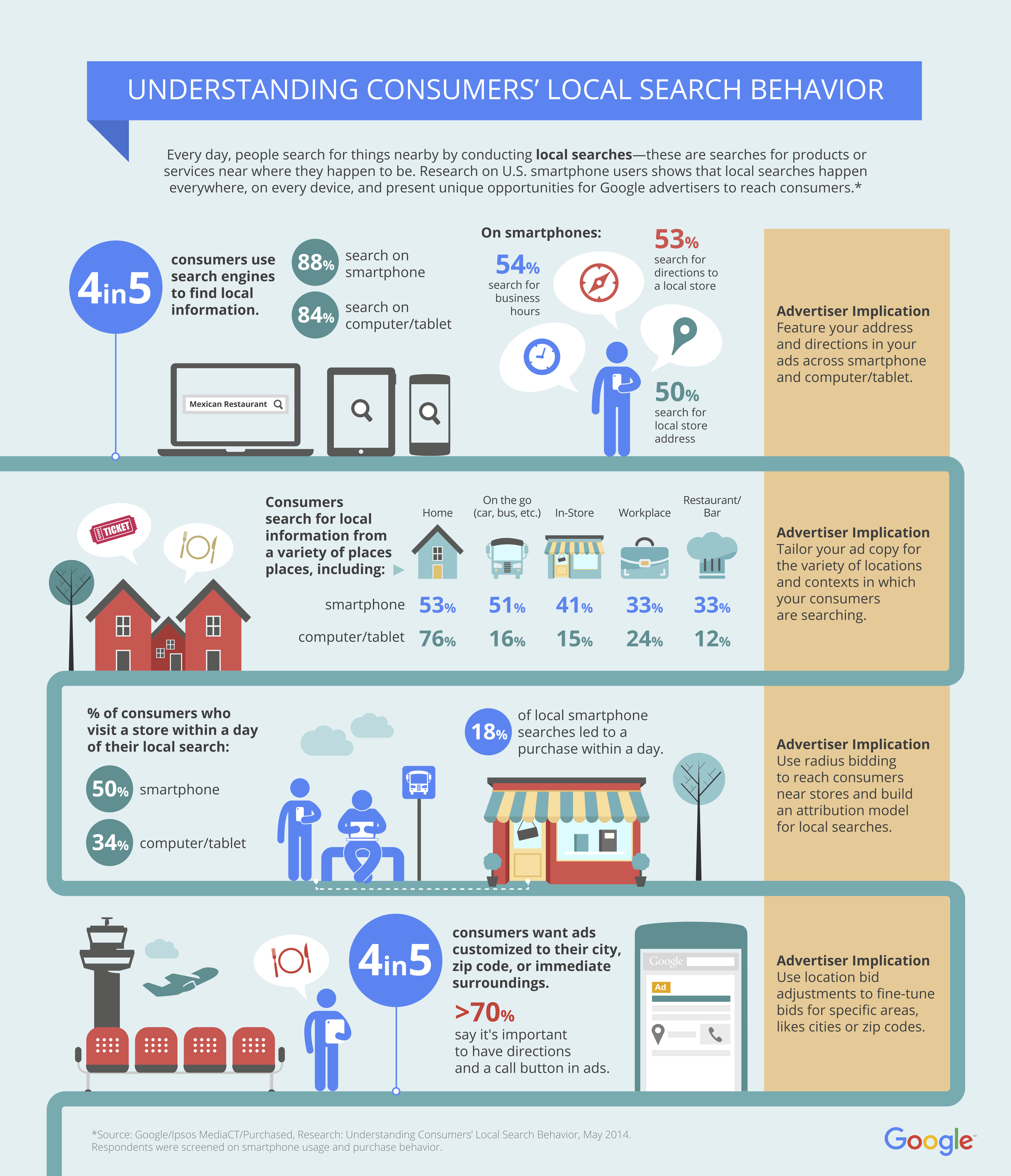
Deciding whether or not to utilize local SEO tactics involves understanding Google’s most important local ranking factors:
Location: Even when users don’t specify locations, Google uses available data to infer approximately where searches are coming from. Geographical distance is very important for local SEO, as Google’s search algorithms prioritize businesses that are physically closer to users.
Relevance: How well a search query matches a local listing is also critical, for all of the same basic reasons that generic internet searches are ordered by relevance.
Authority and/or prominence: How widely known a business is and the sorts of reviews it has is another significant ranking factor in local SEO.
In order to create a meaningful, local SEO strategy and address these ranking factors, SEOs need to:
- Enter business information into Google My Business: A Google My Business profile fast-tracks indexing and updating of Google’s records and ensures higher visibility for relevant local listings.
- Update business information in all local directories: Check that all relevant business information—business name, address, hours and even photos to help people navigate to the location—is up-to-date in any and all area registries. Google and other search engines scan these often.
Technical SEO is Foundational
Though quality content, based on user needs, is the true key to succeeding at SEO, no professional can ignore the technical foundation.
Technical SEO is a set of behind-the-scenes considerations that make a site accessible to search engines. These tasks include work like cleaning up code, improving site speed, using schema markup options, and more.
It is easy to make a checklist of technical SEO tasks, but the truth is, that work no longer drives meaningful SEO growth. There are some important technical SEO considerations that need to be established and maintained in order for a site to compete in organic search, but they don’t, themselves, create SEO wins.

Crucial technical SEO items include:
Load time: Slow pages with a full render load time of more than 10 seconds will lead to higher bounce-rates and quickly discourage visitors from staying to read the content.
Site navigation: Part of giving users a satisfying experience means ensuring they can easily and quickly move from one portion of a site to another. Navigational elements like links, menus, and search bars should all function correctly and be easy to see and use.
Mobile responsiveness: Google’s algorithm is mobile-first, which means that the site’s mobile performance is how Google judges it. Never mind that nearly 75 percent of internet users are expected to search exclusively via mobile by 2025, and 40 percent of users have gone to a competitor’s site after a bad mobile experience. It’s critical that a site be optimized for mobile.
Accessibility: Both users and web crawlers should be able to easily scan a site to determine its contents and relevance.
In addition to mission-critical technical factors, many old-fashioned technical audits and analysts can create a list of dozens (if not hundreds) of technical SEO “errors” for a site. These often seem much more important than they are. Focus on the technical SEO work that will improve rankings and traffic, and don’t waste resources on the rest.
Here are a few steps to take to get a better handle on a site’s technical SEO:
- Check site speed: Take advantage of Google’s free PageSpeed Insights to find out whether or not a page is running smoothly on both mobile and desktop.
- Test mobile responsiveness: Again, Google’s Mobile-Friendly Test is perfect to see if a page works well beyond desktops.
- Improve site accessibility: Provide good UX by using keywords and synonyms naturally. Use formatting like short paragraphs, bulleted and numbered lists, and callouts. Increase search engine crawlers’ ability to index a page by using heading tags, meta descriptions, thoughtful labels and tags for image and video content, etc.
- Conduct a technical audit: These can sometimes be done in-house, but it is often helpful to get an experienced consultant or agency to conduct a thorough technical SEO audit.
Leverage the Right Tools to Help Track and Measure SEO Performance
It’s impossible to know which strategies work and which don’t without some way to track and monitor a site’s performance. That’s where SEO tools come in.

Good tools, combined with strategic SEO expertise, can help marketers create data-driven recommendations for informing updates of existing content, prioritizing specific ranking factors for new content, and more.
In order to leverage data from these tools appropriately, though, developing a list of goals and key performance indicators (KPIs) is critical. Every business is different, so not all KPIs will be appropriate to measure.
However, there are several that tend to be helpful for most SEOs:
– UX signals like CTR, dwell-time, and bounce rate
– Organic sessions
– Conversions from those organic sessions
– Growth of inbound links
There are numerous tools on the market to measure such KPIs. For example, Google’s free Search Console is often an SEO’s first stop. Search Console measures traffic, provides analytics based on that traffic, and offers the ability to set alerts and monitor changes.
Meanwhile, Google Analytics is another free tool for measuring organic traffic to any web page. Google Analytics measures a variety of statistics and KPIs about websites, and allows users to build custom dashboards to track and act on this information.

Be an SEO Rockstar in 2020
SEO isn’t about reverse engineering algorithms for clicks, but rather creating the best content so it lands in front of appreciative eyes, helping to grow positive attention and traffic.
If you have more questions about modern SEO strategies, or want to dig deeper into how to craft winning content, contact Profound Strategy today.

